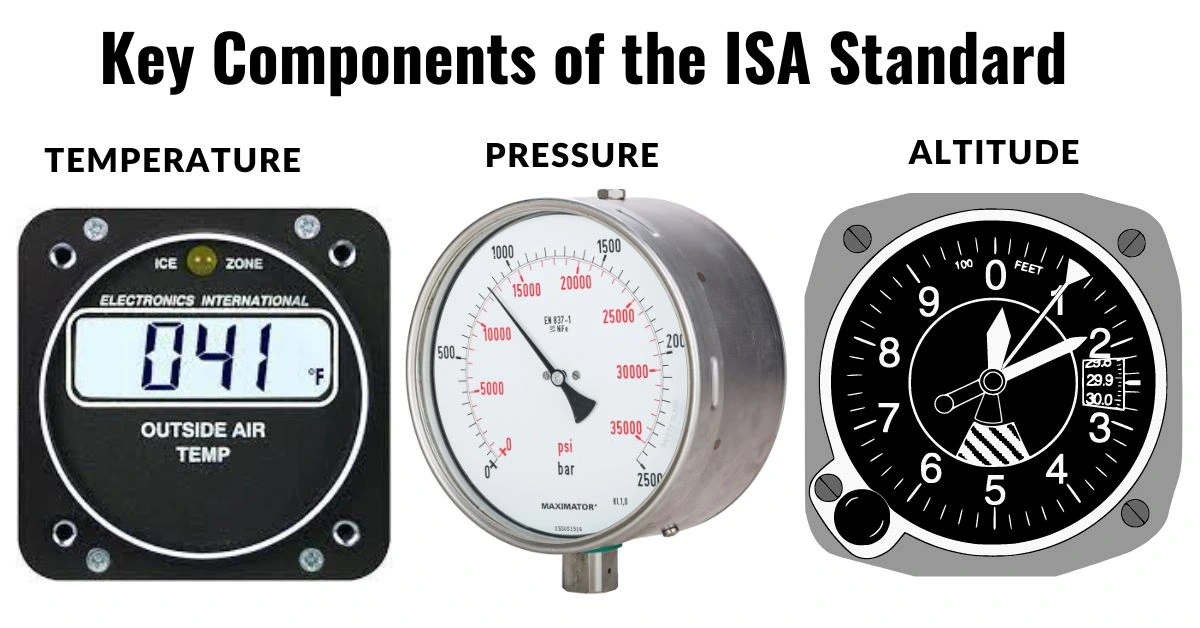In aviation operations, precision in flight planning and safety holds utmost significance. One of the fundamental tools in achieving these objectives is the International Standard Atmosphere, commonly referred to as ISA. The ISA furnishes a standardized framework for understanding Earth’s atmosphere, facilitating precise calculations and informed decisions for pilots and aviation experts.
Find out what is ISA in Aviation operations.
By comprehending the fluctuations in temperature, pressure, and density at various altitudes, the ISA equips pilots with the ability to anticipate aircraft performance under diverse conditions. This knowledge is paramount for flight planning, fuel estimations, and establishing the limits of aircraft performance. Moreover, it plays a pivotal role in upholding aircraft safety and averting potential accidents.
The ISA’s scope extends beyond flight planning; it also functions as a reference for aircraft manufacturers, engineers, and meteorologists. It establishes a uniform baseline for aircraft performance design and testing while aiding in the forecasting of weather patterns and phenomena.
This article will cover the significance of the ISA in aviation, examining its roles in accurate flight planning, safety measures, and industry benchmarks. Join us as we uncover the critical factors that render the ISA an indispensable tool within the aviation sector.
Table of Contents
Importance of Precise Flight Planning and Safety in Aviation
The meticulous planning of flights is central to ensuring the safety and efficiency of air travel. It necessitates the consideration of numerous factors, including weather conditions, airspace restrictions, aircraft capabilities, and fuel consumption. By incorporating these variables, pilots can determine the most optimal route, altitude, and speed for their flights.
Undoubtedly, safety takes precedence in aviation. Accurate flight planning assumes a pivotal role in guaranteeing the safety of passengers, crew members, and the aircraft itself. Armed with knowledge about anticipated flight conditions, pilots can make well-informed decisions and take appropriate measures to avoid potential hazards or risks.
Understanding the ISA Standard in Aviation
The International Standard Atmosphere (ISA) stands as a globally acknowledged benchmark for Earth’s atmosphere. It presents a foundational model for temperature, pressure, and density at various altitudes. The ISA standard is derived from average conditions observed over a specific period, ensuring consistency and comparability in aviation calculations and operations.
According to the ISA standard, sea-level conditions stipulate a temperature of 15 degrees Celsius (59 degrees Fahrenheit) and a pressure of 1013.25 hectopascals (hPa) or 29.92 inches of mercury (inHg). As altitude increases, the temperature and pressure follow specific lapse rates as defined by the ISA.

Key Components of the ISA Standard: Temperature, Pressure, and Altitude
Temperature serves as a pivotal element within the ISA standard. The ISA specifies a lapse rate of 2 degrees Celsius per 1,000 feet or 6.5 degrees Celsius per kilometer. This translates to a 2-degree Celsius decrease in temperature for every 1,000 feet of altitude gain. This lapse rate empowers pilots to anticipate temperature changes during their flights and make necessary adjustments.
Pressure is another critical factor within the ISA standard. As altitude increases, atmospheric pressure diminishes. The ISA dictates a lapse rate of 1 hPa per 30 feet or 1 inHg per 1,000 feet. This information proves indispensable for determining aircraft performance, as pressure fluctuations influence engine power, fuel consumption, and aerodynamic characteristics.
Altitude, the third component of the ISA standard, denotes an aircraft’s height above sea level. Understanding altitude enables pilots to gauge atmospheric conditions like temperature, pressure, and density. This knowledge forms the bedrock of flight planning, allowing pilots to compute aircraft performance limits and make informed choices.
The Role of ISA in Flight Planning

The ISA assumes a critical function in flight planning by providing pilots with precise and standardized atmospheric data. Armed with knowledge about temperature, pressure, and density at various altitudes, pilots can ascertain aircraft performance parameters, fuel consumption, and range. This data empowers them to select the most efficient and secure flight parameters, such as ideal altitude and speed.
Furthermore, the ISA empowers pilots to forecast and plan for potential weather-related challenges. By comprehending expected temperature and pressure fluctuations, pilots can evaluate their impact on aircraft performance and modify flight plans accordingly. This proactive approach bolsters the safety and comfort of passengers and crew members.
Advantages of Implementing ISA in Aviation
Leveraging the ISA in aviation offers numerous advantages. Firstly, it furnishes a standardized reference point for pilots, engineers, and meteorologists. This shared baseline enables consistent calculations and comparisons across diverse aviation operations and regions. It facilitates seamless communication and collaboration among aviation professionals, fostering a collective understanding of atmospheric conditions and their impact on flight operations.
Secondly, the ISA contributes to optimizing flight planning and fuel efficiency. By accounting for temperature, pressure, and density fluctuations at varying altitudes, pilots can pinpoint the most fuel-efficient altitude and speed for their flights. This optimization not only curtails fuel consumption and costs but also lessens the environmental footprint of air travel.
Thirdly, the ISA enhances flight safety by enabling pilots to make informed decisions grounded in accurate atmospheric data. Pilots can anticipate potential hazards or risks stemming from temperature and pressure variations and undertake appropriate measures to mitigate them. This proactive approach significantly diminishes the likelihood of accidents or incidents during flight operations.
Challenges in Implementing ISA in Flight Operations
While the ISA confers numerous benefits, there exist challenges in its effective implementation in flight operations. One challenge lies in the variability of real-world atmospheric conditions. The ISA furnishes a standardized model based on average conditions, but actual atmospheric conditions can deviate substantially from these averages. This variability necessitates continuous monitoring and adaptation by pilots to ensure accurate flight planning and safety.
Another challenge involves the practical constraints of aircraft performance under non-standard atmospheric conditions. The ISA assumes ideal conditions, yet factors such as humidity, wind, and temperature inversions can impact aircraft performance. Pilots must factor in these non-standard conditions and make appropriate adjustments to guarantee safe and efficient flight operations.
Best Practices for Harnessing ISA in Flight Planning and Safety
To effectively harness the ISA in flight planning and safety, aviation professionals should adhere to best practices. Firstly, staying abreast of the latest meteorological information and forecasts is imperative. An understanding of current and projected atmospheric conditions empowers pilots to make informed decisions and tailor their flight plans accordingly.
Secondly, aviation professionals should employ advanced tools and technologies for measuring and calculating ISA parameters. These tools encompass altimeters, onboard air data computers, and computer-based flight planning systems. Leveraging these technologies enables pilots to access precise and real-time atmospheric data, amplifying the accuracy and efficiency of their flight planning and safety protocols.
Lastly, collaboration and communication are pivotal in optimizing the use of the ISA. Aviation professionals should share insights and experiences pertaining to ISA calculations and flight operations. By learning from one another, the industry can continually refine flight planning and safety standards.
Tools and Technologies for Measuring and Calculating ISA Parameters
Various tools and technologies are at the disposal of aviation professionals for measuring and calculating ISA parameters. Altimeters gauge an aircraft’s altitude based on atmospheric pressure, permitting pilots to deduce altitude-dependent variations in temperature and pressure.
Air data computers perform real-time computations of ISA parameters, such as temperature and pressure, grounded in the aircraft’s altitude and other inputs. These computers employ advanced algorithms and sensors to ensure accuracy and reliability in calculations.
Weather stations, whether ground-based or onboard, supply the meteorological data essential for determining ISA parameters. These stations measure temperature, pressure, humidity, and wind speed, providing pilots with a comprehensive grasp of atmospheric conditions and facilitating informed decisions.
Conclusion on ‘What is ISA in Aviation?’
The International Standard Atmosphere (ISA) occupies a central role in ensuring accurate flight planning and safety in the aviation industry. By furnishing a standardized model of Earth’s atmosphere, the ISA equips pilots and aviation professionals with the tools to make well-informed decisions based on precise atmospheric data.
As technology continues to advance, and our understanding of the atmosphere deepens, the ISA is poised to evolve further. More sophisticated tools and technologies will emerge for measuring and calculating ISA parameters. Simultaneously, the aviation industry will persist in refining best practices and standards to harness the ISA effectively in flight planning and safety.
Ultimately, the ISA will endure as an indispensable instrument in the aviation sector, safeguarding the accuracy, efficiency, and safety of flight operations. By embracing the ISA and capitalizing on its benefits, aviation professionals will further elevate the quality of air travel, contributing to the ongoing progress and development of the industry.





